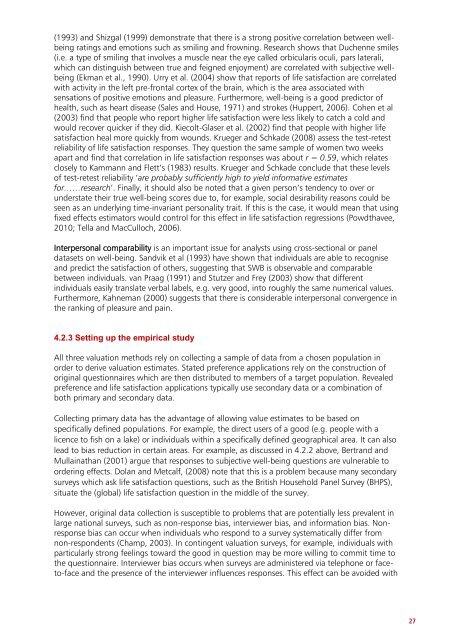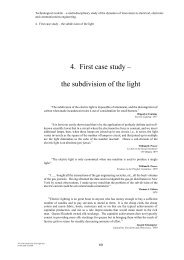Valuation Techniques for Social Cost-Benefit Analysis: - HM Treasury
Valuation Techniques for Social Cost-Benefit Analysis: - HM Treasury
Valuation Techniques for Social Cost-Benefit Analysis: - HM Treasury
Create successful ePaper yourself
Turn your PDF publications into a flip-book with our unique Google optimized e-Paper software.
(1993) and Shizgal (1999) demonstrate that there is a strong positive correlation between wellbeing<br />
ratings and emotions such as smiling and frowning. Research shows that Duchenne smiles<br />
(i.e. a type of smiling that involves a muscle near the eye called orbicularis oculi, pars laterali,<br />
which can distinguish between true and feigned enjoyment) are correlated with subjective wellbeing<br />
(Ekman et al., 1990). Urry et al. (2004) show that reports of life satisfaction are correlated<br />
with activity in the left pre-frontal cortex of the brain, which is the area associated with<br />
sensations of positive emotions and pleasure. Furthermore, well-being is a good predictor of<br />
health, such as heart disease (Sales and House, 1971) and strokes (Huppert, 2006). Cohen et al<br />
(2003) find that people who report higher life satisfaction were less likely to catch a cold and<br />
would recover quicker if they did. Kiecolt-Glaser et al. (2002) find that people with higher life<br />
satisfaction heal more quickly from wounds. Krueger and Schkade (2008) assess the test-retest<br />
reliability of life satisfaction responses. They question the same sample of women two weeks<br />
apart and find that correlation in life satisfaction responses was about r = 0.59, which relates<br />
closely to Kammann and Flett‘s (1983) results. Krueger and Schkade conclude that these levels<br />
of test-retest reliability ‗are probably sufficiently high to yield in<strong>for</strong>mative estimates<br />
<strong>for</strong>……research‘. Finally, it should also be noted that a given person‘s tendency to over or<br />
understate their true well-being scores due to, <strong>for</strong> example, social desirability reasons could be<br />
seen as an underlying time-invariant personality trait. If this is the case, it would mean that using<br />
fixed effects estimators would control <strong>for</strong> this effect in life satisfaction regressions (Powdthavee,<br />
2010; Tella and MacCulloch, 2006).<br />
Interpersonal comparability is an important issue <strong>for</strong> analysts using cross-sectional or panel<br />
datasets on well-being. Sandvik et al (1993) have shown that individuals are able to recognise<br />
and predict the satisfaction of others, suggesting that SWB is observable and comparable<br />
between individuals. van Praag (1991) and Stutzer and Frey (2003) show that different<br />
individuals easily translate verbal labels, e.g. very good, into roughly the same numerical values.<br />
Furthermore, Kahneman (2000) suggests that there is considerable interpersonal convergence in<br />
the ranking of pleasure and pain.<br />
4.2.3 Setting up the empirical study<br />
All three valuation methods rely on collecting a sample of data from a chosen population in<br />
order to derive valuation estimates. Stated preference applications rely on the construction of<br />
original questionnaires which are then distributed to members of a target population. Revealed<br />
preference and life satisfaction applications typically use secondary data or a combination of<br />
both primary and secondary data.<br />
Collecting primary data has the advantage of allowing value estimates to be based on<br />
specifically defined populations. For example, the direct users of a good (e.g. people with a<br />
licence to fish on a lake) or individuals within a specifically defined geographical area. It can also<br />
lead to bias reduction in certain areas. For example, as discussed in 4.2.2 above, Bertrand and<br />
Mullainathan (2001) argue that responses to subjective well-being questions are vulnerable to<br />
ordering effects. Dolan and Metcalf, (2008) note that this is a problem because many secondary<br />
surveys which ask life satisfaction questions, such as the British Household Panel Survey (BHPS),<br />
situate the (global) life satisfaction question in the middle of the survey.<br />
However, original data collection is susceptible to problems that are potentially less prevalent in<br />
large national surveys, such as non-response bias, interviewer bias, and in<strong>for</strong>mation bias. Nonresponse<br />
bias can occur when individuals who respond to a survey systematically differ from<br />
non-respondents (Champ, 2003). In contingent valuation surveys, <strong>for</strong> example, individuals with<br />
particularly strong feelings toward the good in question may be more willing to commit time to<br />
the questionnaire. Interviewer bias occurs when surveys are administered via telephone or faceto-face<br />
and the presence of the interviewer influences responses. This effect can be avoided with<br />
27





![AIRTO [Professor Dr Brian Blunden] - HM Treasury](https://img.yumpu.com/15492848/1/184x260/airto-professor-dr-brian-blunden-hm-treasury.jpg?quality=85)










